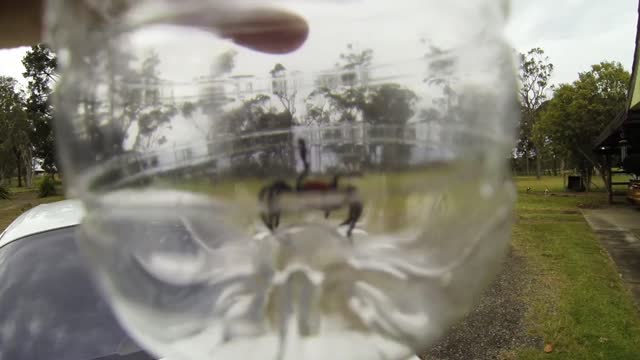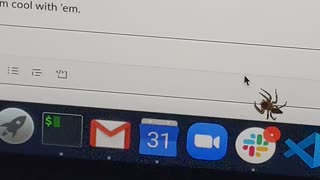Premium Only Content

Red-Headed Mouse Spider - Missulena Occatoria (male)
Red-headed Mouse Spiders have a smooth, glossy carapace and their head area is high, steep and broad with very large, bulbous jaws. Their eyes are widespread across the front of their head. The spinnerets, at the back of the abdomen, are short and blunt, the last segment domed and button-like.
Female Red-headed Mouse Spiders are large, stout spiders with short legs. They tend to be uniformly dark brown to black all over, however their jaws are sometimes red-tinged. Female Red-headed Mouse Spiders are much larger than the males.
Male Red-headed Mouse Spiders have a bright red head and jaws and a gunmetal blue to black abdomen. They have thinner and longer slender legs without mating spurs. They are much smaller than the females.
Like the trap-door spiders, the mouse spider lives in burrows in the ground, often in banks of rivers, creeks and other waterways, and is sometimes found in suburban gardens. The burrows are built with double or single trapdoors and the entrance is oval-shaped. Some species have a side chamber extending of the main burrow shaft, usually closed by a trap door. It provides a refuge from predators and a safe place for the egg sac and spiderlings.
Red-headed Mouse Spiders can be found in open forest to semi-arid shrub-land habitats.
The females tend to remain in or near their burrows throughout their life, and are sluggish spiders that are rarely aggressive.
Red-headed Mouse Spiders (Missulena occitoria) have the largest distribution of all the Mouse spiders. They are found across mainland Australia, however mainly west of the Great Dividing Range.
The male Red-headed Mouse Spiders are usually found wandering for females during the day in late summer (Feb)to early winter months (Jun). They tend to be more common especially after rain. Females remain in their burrows.
Males reach sexual maturity at about four years. They leave their shallow burrows during the breeding season to find a mate. They are unusual in that their wandering behaviour occurs during the day, unlike other mygalomorph spiders, whose males are night wanderers. While wandering, male mouse spiders hold their long pedipalps (carrying the mating organs) extended forwards, presumably seeking an airborne scent (pheromone) associated with the female or its burrow. Once the burrow is located the male taps the ground and silk around the doors until the female emerges. If she is receptive the male follows her into the burrow where mating occurs.
The female lays 60 or more eggs within an egg sac that she places into a brood chamber off the main shaft of her burrow. The spiderlings hatch from the egg sac over summer and remain with the mother into autumn when dispersal occurs.
The spiderlings of the Red-headed Mouse Spider disperse by ballooning, a technique that is rare in mygalomorphs. This explains the relatively wide distribution of Red-headed Mouse Spiders compared to other mygalomorph species.
Mouse Spider venom may be very toxic, but few cases of serious envenomation has been recorded. Other bites have occurred causing minor effects. Funnel-web spider antivenom has proved effective in the one confirmed case.
Until more toxicity data is available it is prudent to treat as for Funnel-web spider bite, especially if the victim is a child. Apply a pressure bandage over the bitten area as high up the limb as possible. Immobilise the victim. Collect the spider for positive identification. Do not wash venom off the skin, as retained venom will assist identification.
-
 0:29
0:29
Buzzvideos - EN
4 years agoSpider chases mouse pointer
16 -
 0:24
0:24
ViralHog
4 years ago $3.45 earnedSpider Chases Mouse
4.52K -
 0:18
0:18
thompcomp
4 years agoSpider Girl
100 -
 0:50
0:50
brokenreel23
4 years agoSpider crabs!
53 -
 0:21
0:21
Music & Other Fun Videos
4 years ago $0.01 earnedSpider Solitaire
68 -
 0:33
0:33
brokenreel23
3 years agoMore spider crabs
17 -
 1:56
1:56
Kantanshi
4 years agoHunting jumping spider
47 -
 1:06:58
1:06:58
The White House
3 hours agoPress Secretary Karoline Leavitt Briefs Members of the Media, Feb. 25, 2025
43.8K24 -
 1:34:46
1:34:46
Russell Brand
4 hours agoControl Slipping: Germany’s Vote, Ukraine, Apple, and Joy Reid – SF543
96.2K25 -
 57:44
57:44
Winston Marshall
3 hours ago“They Were Hiding THIS!” Michael Shellenberger UNCOVERS Dark Secret About USAID and The Deep State
39.2K16